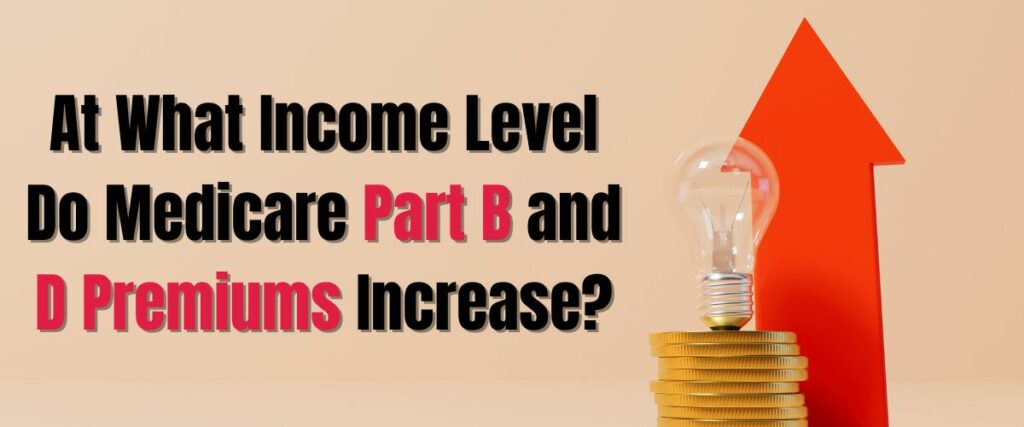At What Income Level Do Medicare Part B and D Premiums Increase?
Understanding how your income limit affects your Medicare premium costs can be confusing. Amounts for Medicare Part B and Part D premiums can increase significantly once your income exceeds certain thresholds based on your tax return from two years earlier. This comprehensive guide examines how Medicare calculates your income-based premiums, at what income levels your costs will rise, and what options you have if your income changes after you file your taxes.
Your Tax Return to Determine Medicare Premiums in 2023
Medicare bases the premiums you pay for Part B medical insurance and Part D prescription drug coverage on your income reported two years prior on your IRS tax return. This means your 2023 Medicare premiums will be based on your modified adjusted gross income (MAGI) from your 2021 taxes filed in 2022.
Medicare doesn’t look at your current income situation when setting your premium costs. So even if your income has dropped recently, you could still face higher Medicare premium surcharges known as income-related monthly adjustment amounts (IRMAA) next year based on the prior years’ tax return.
Understanding how the Medicare income limits formula works is important, as many retirees end up paying higher premiums without realizing why their Medicare costs are suddenly much higher. This guide provides in-depth information on income limits for Medicare depending on your income, at what income levels your costs will rise, and steps to take if your income has declined.
How Medicare Calculates Premiums Based on Income Limit
When determining your Medicare coverage Part B and D premiums, Medicare looks at your modified adjusted gross income (MAGI) from your federal income tax return from two years prior.
For example, your 2023 Medicare premiums are based on your MAGI from your 2021 tax return that you filed with the IRS in 2022. Your MAGI includes your adjusted gross income (AGI) plus any tax-exempt interest income you received that year.
If you file your taxes jointly with a spouse, Medicare will look at your combined MAGI to determine if your household income exceeds the thresholds for higher premiums. The income cutoffs are higher for married couples filing jointly than for individual tax filers.
Medicare uses your most recent tax return information they have on file to calculate your income-based premiums. There is no need to self-report any income changes or provide updated documentation on your own. Medicare and Social Security get your tax data directly from the IRS.
The only way your 2023 Medicare premiums could be lowered after they’ve been set based on your 2021 tax return is to successfully appeal by proving your income has dropped substantially since that prior year tax filing. The appeal process can be complex, so see the section below on what to do if your income declines.
Higher Income Results increase in Medicare Part B Premiums
Most Medicare beneficiaries pay the standard monthly premium for Part B, which will be $164.90 per month in 2023. However, if your income rises above $97,000 as an individual tax filer or $194,000 as a married couple filing jointly, you’ll pay the following income-related monthly adjustment amounts (IRMAA) in addition to the standard premium:
- $238.10 per month for individual income between $97,001-$123,000
- $340.20 per month for individual income between $123,001-$160,000
- $442.30 per month for individual income between $160,001-$500,000
- $544.40 per month for individual income above $500,000
The IRMAA premium brackets for married couples filing jointly are approximately double the individual amounts listed above.
You may also pay an income-based surcharge for Medicare Part D prescription drug coverage ranging from $12.20 up to $77.90 per month depending on where your income falls.
These figures apply to 2023 Medicare premium costs. The brackets typically rise slightly each year based on inflation. So while most Medicare enrollees pay standard premiums, higher earners pay progressively more for Parts B and D coverage based on their prior year’s taxable income.
Why Medicare Bases Premiums on Your Prior Year’s Taxable Income
Given that Medicare premium surcharges apply to income from two years prior, some beneficiaries wonder why this prior year tax data is used to determine current Medicare costs. There are a few reasons Medicare relies on your older tax return information:
- Provides verified tax data – Using IRS records means incomes are verified rather than self-reported estimates.
- Delivers consistent measurement – Tax returns offer a consistent way to assess income for all Medicare enrollees nationwide.
- Allows processing time – Medicare needs several months to analyze tax returns and notify members of 2023 premium adjustments based on 2021 taxable income.
- Accounts for income drops gradually – Basing premiums on prior year returns means sudden income decreases don’t immediately lower Medicare costs.
So while not a perfect system, using older tax returns gives Medicare a standardized data source to calculate each beneficiary’s premium costs based on their unique financial situation.
What to Do If Your Income Changes After You File Your Taxes
Many Medicare beneficiaries have stable incomes from year to year. But some retirees see their earnings decrease substantially due to job losses, retirement, investment declines or other drops in taxable income.
If your income has gone down significantly since the tax return Medicare used to calculate your 2023 premiums, you have the right to appeal your Medicare costs. However, the process involves paperwork and documentation.
To appeal higher premiums, you’ll need to gather proof of your reduced current income from sources like recent pay stubs, Social Security benefit letters, pension statements or investment account summaries showing portfolio declines.
Submit this documentation to Medicare asking for a reassessment of your premiums based on your 2022 estimated income. Be aware that Medicare appeals take time, often 2-3 months to review. So you’ll need to continue paying the higher premiums while your appeal is processed.
If Medicare confirms your income has gone down enough to lower your premium tier, you’ll receive a refund of any overpaid premium costs. Going forward, your Medicare premiums will be reduced based on your new verified income level.
So appealing Medicare premiums is an option if your earnings decrease substantially from one year to the next. Just be prepared for a potentially slow process requiring patience and persistence.
How Alaska and Hawaii Premiums Differ from Other States
Most Medicare premium, deductible and threshold amounts are standard across the 50 U.S. states and Washington D.C. However, beneficiaries living in Alaska and Hawaii do face slightly higher Medicare costs.
In 2023, the standard monthly Part B premium for Alaska is $206.50 and for Hawaii it’s $192.70. That’s about 25% higher than the $164.90 premium that applies in the other 48 states.
Income-related monthly adjustment amounts for higher earners are also a bit larger in Alaska and Hawaii. Geographic-based variations recognize the higher cost of living and healthcare in these two non-contiguous states.
So while most Medicare costs are consistent nationwide, be aware that Parts B and D premiums are somewhat higher if you reside in Alaska or Hawaii and have income exceeding the IRMAA thresholds.
Strategies to Minimize Your Medicare Costs
While you can’t control Medicare’s use of your prior year taxable income to set premiums, below are some tips to manage costs within your control:
- Comparison shop carefully during open enrollment each fall – Medicare Plans and costs can change annually.
- Consider Medicare Advantage Plans with $0 premiums beyond Part B to limit expenses.
- Pick Part D Plans with premiums averaging around $20-40/month unless you take expensive drugs.
- Use mail-order pharmacies, generics and preferred brand drugs to reduce prescription outlays.
- Apply for Medicare Savings Programs if you have limited income and resources to get premium assistance.
The more you understand how Medicare calculates premiums along with your coverage options, the better able you’ll be to reduce expenses while still getting the healthcare services you need.
Conclusion and Summary of Main Points
- Medicare bases your Part B and D premiums on your taxable income from two years earlier as reported to the IRS.
- If your income exceeds set thresholds, you’ll pay IRMAA surcharges on top of standard premium amounts.
- Most people pay for Medicare standard premiums, but higher earning enrollees pay more based on their MAGI.
- You can appeal higher premiums by proving your current income is substantially lower.
- Strategize during open enrollment to find and get Medicare Plans with affordable premiums and out-of-pocket costs.
Knowing how your income affects Medicare premiums can prevent unexpected surcharges down the road. Be sure to understand these income-based rules so you can anticipate and budget for accurate Medicare expenses each year
We’re Here to Help
You do not have to spend hours reading articles on the internet to get answers to your Medicare questions. Give Scott Sims at Sims Insurance Medicare Plans a Call at (541) 915-0939. You will get the answers you seek in a matter of minutes, with no pressure and no sales pitch. We are truly here to help.
FAQs
How does my income affect what I pay for Medicare Part B?
Medicare uses your total adjusted gross income from 2 years ago to determine if you’ll pay the standard Part B premium or a higher amount. This is called your income-related monthly adjustment amount (IRMAA). Your premium for 2023 is based on your 2021 income.
How much is the standard Medicare Part B coverage in 2023?
The standard Part B premium in Medicare in 2023 is $164.90 per month. If your income is above certain thresholds, you may pay a higher IRMAA premium based on your tax return filed in 2022 for tax year 2021.
What are the different parts of Medicare?
Original Medicare includes Part A (hospital coverage) and Part B (medical coverage). Medicare Advantage Plans are Part C, and prescription drug plans are Part D. There are also Medicare Supplement Plans to help cover costs.
Where can I learn more about Medicare costs?
Visit www.Medicare.gov for details on Medicare premiums, deductibles, and other costs. This site lets you compare plans and shows if your income requires you to pay higher Part B or Part D premiums.
How much will I pay for Medicare Part B in 2023 based on my income?
The standard Part B premium is $164.90 in 2023. However, if your 2021 total adjusted gross income as reported on your 2022 tax return exceeds $97,000 as a single filer or $194,000 if married filing jointly, you may pay an income-related monthly adjustment amount (IRMAA) ranging from $230.80 to $578.30 per month.


